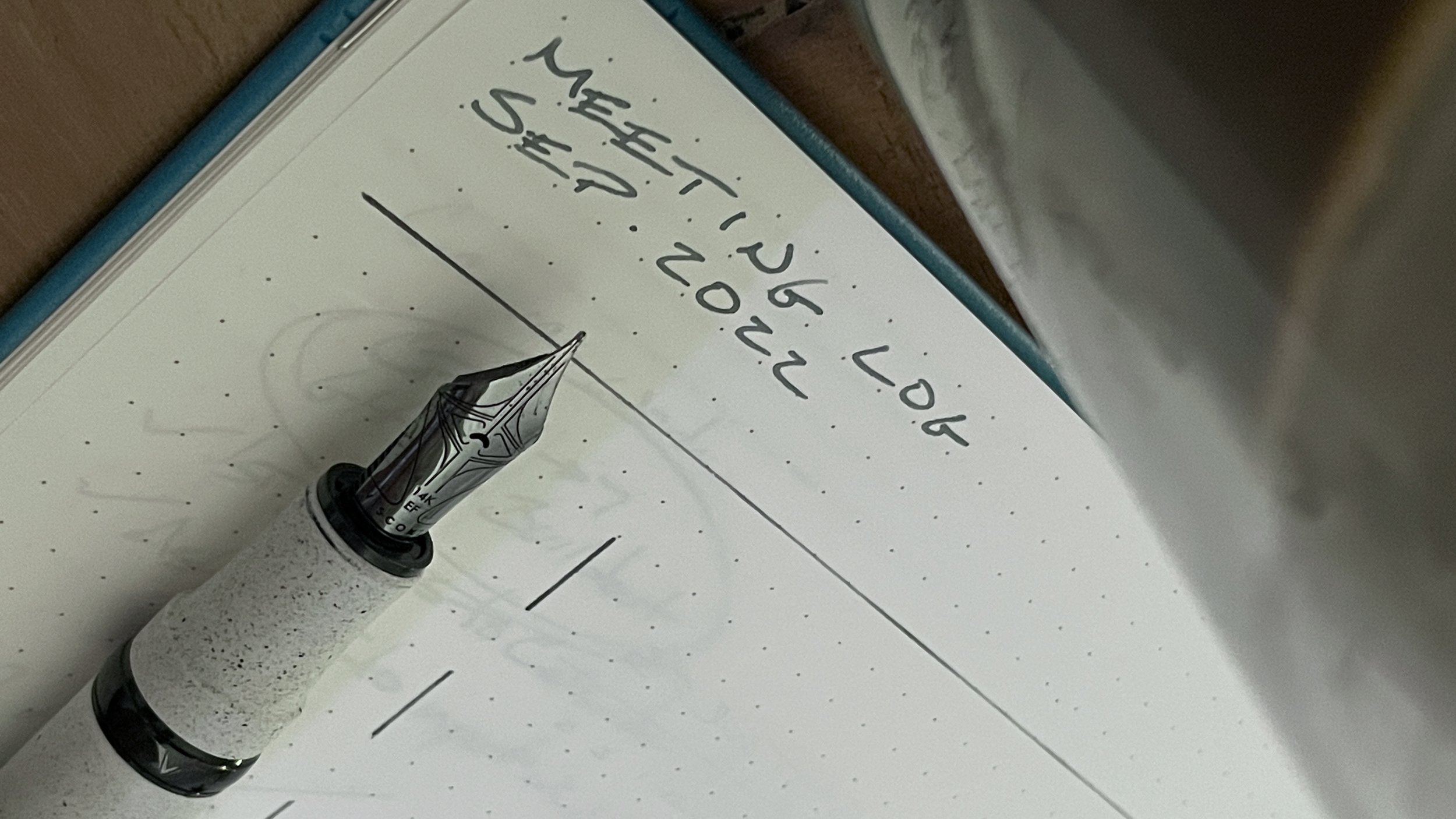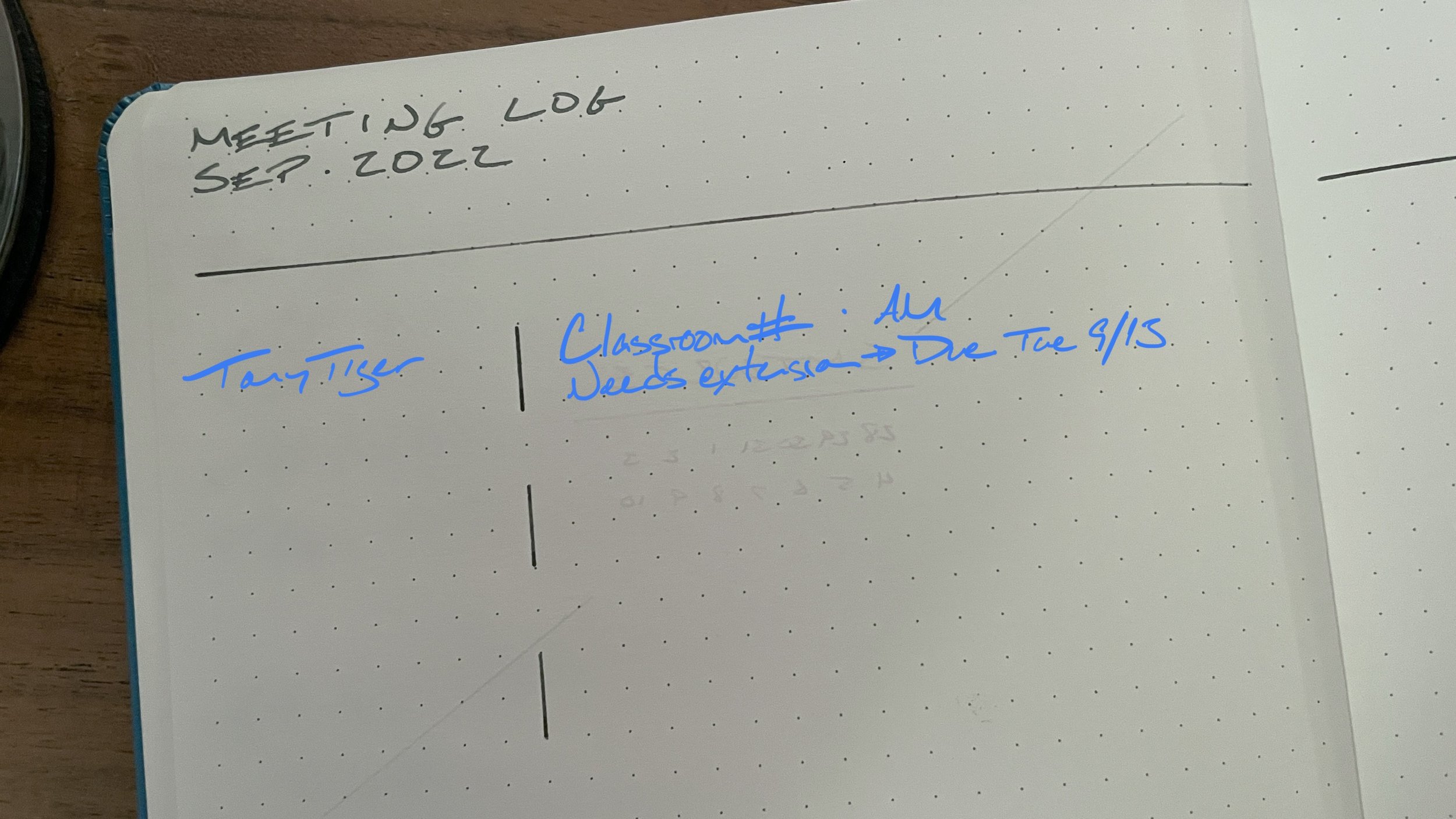The bits and bobs of my teaching bullet journal: Meeting logs
I live in my teaching bullet journal during the school year. The notebook houses everything from curriculum revision to my day-to-day task lists to a host of meeting notes. Brainstorms on lesson sequencing, calendars pacing assignments to fit students’ needs, and periodic analytic reflections to assess whether what I intend to teach is what I’m actually communicating.
The notebook carries three kinds of weight for me during the school year. One is space for keeping targeted kinds of often-referenced information. Another is a space for reflecting and honing my thinking: both on teaching and administrative “stuff.” Third is space for tracking rapidly shifting obligations and what needs doing.
A lot. Between 400 and 500 pages of notes over the course of a school year. This month, I’m sharing what my most-used page layouts look like. The organization that enables my to carry triplets of proverbial weight. The core parts of my teaching bullet journal.
Meeting logs (you’re here)
Task pages: brainstorms and weeklies
This week: the deceptively simple meeting log.
It’s log … from Blammo
Meeting logs. Specialized running indexes. I track which student or parent I met with, when and how we met, what we covered, and the outcome of each meeting. Recording meetings’ outcomes is key for me.
Noted in keywords. Two lines or fewer. Just enough to jog memories.
My ability to accurately reference the ultimate call to action from a conference — or the resolution we came to — sits at the heart of 9-of-10 of my parent and student meetings.
And administrative meetings about said parent and student meetings. My life hath become meetings.
I sketch out a new meeting log every month. Monthly separations help me keep my log searchable more quickly. It’s easier to find one specific record amongst 30 rows than from within 90 possibilities.
Detailed skimming for the skimmer of details
Narrow nibs (F and EF) work best for meeting logs. I can cram multiple keywords on each line when lines are narrow. All legible weeks or months afterwards — when I refer back to this log.
Putting names on the far left makes the log easily skimmed by student. The vertical line separates names from the rest of my recorded info also visually separates individual meetings from one another. Quick, dirty, and effective.
This week’s Inked Tines update includes last week’s currently inked writing tools.
Toolset
Pens. This week’s standout pen-and-ink combo is The Nakaya Neostandard (M Naginata), inked with Taccia’s Sharaku-Koiame. Japanese M line width. A dry combination that brought of Koiame’s fun shading. Suitable for accent notes, margin notes in reverse writing, and longform reflections at low angles to the paper. Journaling, reading notes, meeting notes, and brainstorming. Fun times. Feed only.
Pilot Custom 74 (EF) — Empty. Superb pairing. Smooth consistent flow and brief dry time. With shading. Wonderful detailed notetaker and task manager. Bujo layouts, meeting notes, task management, some pocket notes, reading notes, and commonplace notes.
Sailor Pro Gear (Z) — Feed. Multiple personalities. Wet, dark lines at the beginning of a writing session. Dusty, high-shading letters towards the bottom of a written page. Two personalities add fun to longform writing. Compact Pro Gear worked well as a pocket carry. Meeting notes, pocket notes, journaling, and reading notes.
Franklin-Christoph 03 (F SIG) — 1/4. Wet ink flow insulates the crisp edges of Franklin-Christoph’s SIG nib. Enough so that I was able to write comfortably even during quick moving meetings. A feat for any italic grind. Meeting notes, reading notes, commonplace notes, and curriculum review.
TWSBI 580-AL (B) — 1/3. Fukagawa-nezu grew on me the more I wrote with it. Plentiful haloing and fun shading paired with this B nib. Great for headings and meeting notes. Also for journaling and teaching reflections. Solid.
Carolina Charlotte (B) — 1/3. Consistent wide B lines. Healthy sheen. Suited well for highlighting new tasks that arise during meetings. Made migrating those tasks into my agenda easy-peasy. Also: journaling. And commonplace notes. And curriculum review notes. This was a magnetic combo.
Notebooks. Work bujo. Odyssey Neptune 400 (A5). Life started the school year on page 23. I added sixteen new pages to my teaching bullet journal. The notebook will begin next week on page 39. A roaring start.
Roaring into September next week
Eleven of last week’s sixteen page notetaking spree are meeting notes. The Pilot 74’s fracturous EF lines dominate. Small, detailed scrawlings with fun, present shading. It pays to be present.
One meeting on Thursday morning was a firehose of information. Faculty gather to share information on how individual students learn best — to the benefit of those who teach those students this year.
I tapped the forgiving Sailor Zoom nib for this meeting. The round nib accommodated awkward writing angles that played out while I attended to both my notes and the conversation-at-jog.
Jogging tracks … in purple
Journal. LIFE x Kleid Noble Note (B6). Thirteen new pages of journaling take me across the border into my LIFE notebook’s fourth and final signature. 75% complete.
I recorded five entries over the course of last week. Three are longform journal entries. Paragraphs of text focused on unpacking parts of their respective day’s events.
I opted for broad nib choices. The Nakaya’s fun M Naginata, the TWSBI’s stock B, and the Sailor’s pear-shaped Zoom.
I washi taped a card into my entry. So now there’s stationery on the stationery that’s in my stationery … I may have an addiction …
The remainder are varied. One page of brainstormed notes capturing ideas for this coming week. Two pages of scribbles and ink testing from a Friday evening hangout with a friend. A friend who was generous enough to bring a collection of vintage pens to play with.
A friend with vintage pens is a friend indeed
And it’s now time for journal notebook shopping. Oh yes it is.
Written dry. The Pilot 74 emptied during a meeting to plan our year’s curriculum on diversity, equity, and inclusion for our faculty.
Three weeks is an admirably long time for a daily driver to stay active. Pilot’s excellent hairline EF lines spread an ink fill quite well. A great option for long trips.
Both the Sailor and Nakaya continue to write with only the ink in their feeds remaining. This duo also lasted three weeks in rotation. Survivors.
Ink levels low-enough to warrant swapping out for next week’s currently inked.
Newly inked. I stuck to my starting seven this week. Chalk up a point for self-control.
The collection
Incoming / new orders. No new purchases this week. Perhaps a second chalky point?
Outgoing / trades or sales. I loaned the TWSBI Eco-T to my vintage-pen-attuned friend on Friday night.
The Eco is a great first TWSBI experience. And I believe an excellent example of accessible modern pens done well.
Currently reading and listening
Fiction. I finished Ryan’s The Martyr early Tuesday evening. Bloody. Tightly-written. And quickly paced.
The end snuck up on me. The percent-complete trackers in Apple’s Books app include chapter samples from other texts that are sometimes appended to the end of the book’s file.
I have Cixin Liu’s second novel, The Dark Forest, on deck. From the woods of Althiene to the trippy space-world of Trisolaris.
Nonfiction. I also made healthy progress in my close-read of Stanley’s How Propaganda Works. Six of nine chapters are now accounted for.
My close reads result in thoughtful margin notes and ties between arguments. Close reads also result in outlines questions and critiques of my own. And so fodder for additions to my commonplace notebook.
Metal book darts point the way
Music. I have an admission to make. I’m still listening obsessively to Sleepy Fish’s latest release. Sleepy Fish is a happy soundspace for me while working and writing.
So, for a change of pace, I’m sharing the animated video for A Note from my Book. My good friend JG often plays these videos for his kids while his family gets ready in the mornings. Kid friendly, mellow lo-fi.











